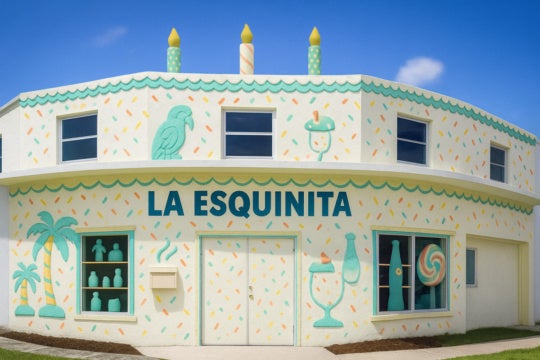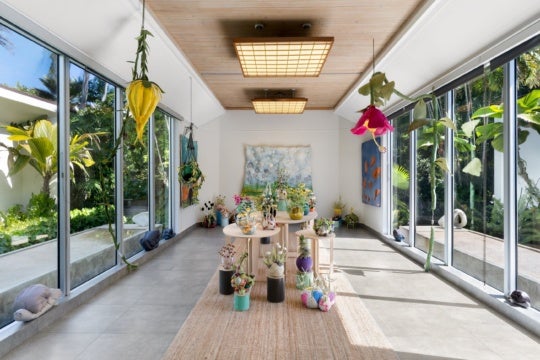
For the past seventy years, George Dunbar has painted in Louisiana. Characterizing his career as “an accidental triumph”—a sentiment echoed in the title of the recent presentation of his work at the New Orleans Museum of Art, “George Dunbar: Elements of Chance”—Dunbar’s artistic contribution and legacy consists of much more than a bit of spontaneous luck. It is this tension between instinct and intention that structures the entirety of Dunbar’s career. A New Orleans native, Dunbar is credited with the introduction of abstract art to the South in the 1950s and catalyzing a context for modern art in Louisiana that championed experimentation, individuality, and a rich engagement with materials. However, what the NOMA exhibition makes visible is Dunbar’s participation and activation of an art community that continues to nourish and support artists, institutions, and patrons today. More than a traditional, chronological unfolding of an artist’s aesthetic development, “Elements of Chance” encourages reflection on the historical trajectory and circumstances of art in the Delta.
Dunbar’s early career is marked by his engagement with and awareness of the thriving contingent of action painters and galleries in Manhattan that paved the path to American abstraction in the 1950s, and this is a relationship that NOMA places at the heart of the exhibition. However, Dunbar also worked across his career as a successful land developer, and his familiarity with the particularities of Louisiana’s soil and topography finds a crucial place within each of his works. Red M (1959), an early hybrid work of thick red, pink, and neutral tones of acrylic paint and collage elements, reveal Dunbar’s exposure to the New York School painters, specifically, the dense gestural qualities of Franz Kline’s monumental canvases, which work to spatially and temporally transcend the historical legacies of illusionism and pictorial synthesis in visual art.

Thus, the work also bears witness to Dunbar’s deep regard for “place,” the collage elements integrated into the space of the image a constant reminder of the scraps and fragments that appear in an artist’s studio and the muddy neutrals suggesting the thick clay grounds of the swampy Louisiana bayou. Dunbar’s style and methods would have certainly been a shock to an audience of artists and local viewers with little to no exposure to the style or context of abstraction—a recognition that 21st-century audiences have difficulty remembering or accounting for, now that abstraction has become the “official” style of corporate institutions all over the world. What appears consistently in Dunbar’s works is the confrontation between the national and the local, the traditional and the emerging. His works make visible a pivotal moment in the history of American art where conversations regarding authenticity and regionalism—issues that have long underpinned the ideological history of the United States—were still in formation.
The 1950s also saw the integration of clay as well as gilded materials such as gold leaf and silver leaf that would define his later style . Natural materials with rich social and political histories in art, these metallic additions—with their unique tactile qualities and unpredictable behaviors—expanded the possibilities available to him as a painter. An untitled work from 1965-1970 is an example of this turn towards metallic surfaces, but places the materials in the context of hard-edged painting, geometric abstraction, and psychedelic abstraction circulating in the vanguard circles of American and British art during the 1960s.

While the metallic tonalities turn the surface of the work into an expansive field of cold illumination, a sense of the natural world and its organic forms are never far behind in Dunbar’s work—in many ways, the natural world is raised up to its rightful place as model for the objective rationalities lying at the heart of the modernist project. This is felt most intensely in the repetitive circular cuts into the panel, an obvious referent to the interior rings of trees scattered across Louisiana’s coasts and forests. In addition, Dunbar’s own use of gold leaf—a material with religious significance for the diverse constellation of Western Catholic and Creole spiritual traditions that mark this region—can be found in the work of many other Louisiana artists of Dunbar’s generation, such as Lin Emery’s large-scale sculptures and Shearly Grode’s mixed-media works. Dunbar’s incorporation of new materials with visual and tactile qualities associated within the visual culture of New Orleans opened up new possibilities for modern art’s assumed disinterest in the referent.
Dunbar’s more recent style could be perhaps thought of as a synthesis of old and emerging interests at work within the artist’s oeuvre, proving the exhibition to be a narrative of an artist’s career that is still evolving, exploring, and rewinding simultaneously. Le Rouge Grande (2015), a striking horizontal stretch of red and silver, calls up the familiar widths of color associated with Color Field painting and yet is interrupted by the diverse collection of natural materials that present themselves uniquely within the picture plane.

Red clay from the bayou provides the ground for the works, taking the bleeding heat of Mark Rothko’s spiritual atmospheres to new heights, while the shivering silver tones of palladium are placed under different stresses—cut, spread, thrown, and chopped into the central space of the work to register depth of field and perspective. It is a bold work, one that does not sit in complacency but foregrounds the handmade gestures of making that lay at the foundations of creative practice and the local materials that inspire it. As a Dunbar work, it stands as indicative of a life-long commitment to process and provisions.
“George Dunbar: Elements of Chance” is on view at the New Orleans Museum of Art through February 19.
Jordan Amirkhani is an assistant professor of art history at the University of Tennessee Chattanooga. In addition to her academic work, she serves as a regular contributor and art critic to many national arts publications, namely, the San Francisco-based contemporary art forum Daily Serving.




